Excerpts from Jim Conrad's
Naturalist Newsletter
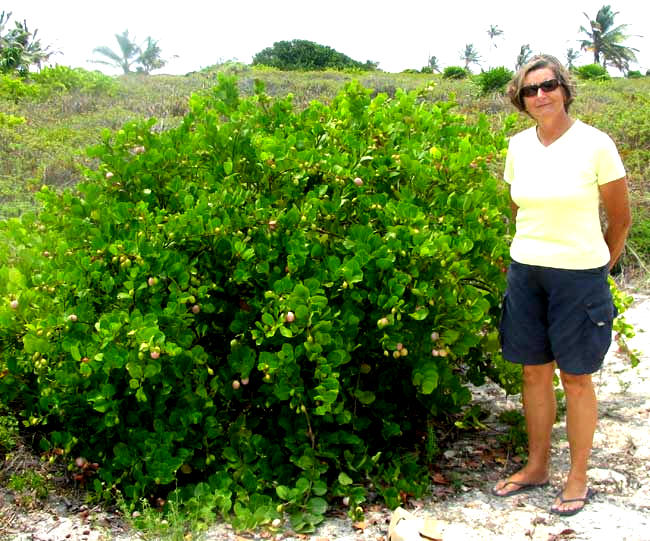
from the May 1, 2011 Newsletter issued from Mayan Beach Garden Inn 20 kms north of Mahahual; Caribbean coastal beach and mangroves, ~N18.89°, ~W87.64°, Quintana Roo state, MÉXICO
ICACO
On Wednesday morning some visitors needed to be dropped on the beach in Sian Ka'an so they could beach-hike for about ten miles, then be picked up later, so I rode up with Marcia, co-owner of Mayan Beach Garden. You can see Marcia standing beside the interesting bush found there at the top of this page.
In English the bush is called Icaco or Cocoplum. It's CHRYSOBALANUS ICACO, a member of the Chrysobalanus Family, little known to Northern nature lovers, because its approximately 460 species in 17 genera are restricted to the American tropics and subtropics. The family is close to the Rose Family.
The eye-catching feature about this bush was that it was loaded with plum-size, white fruits, as seen below:
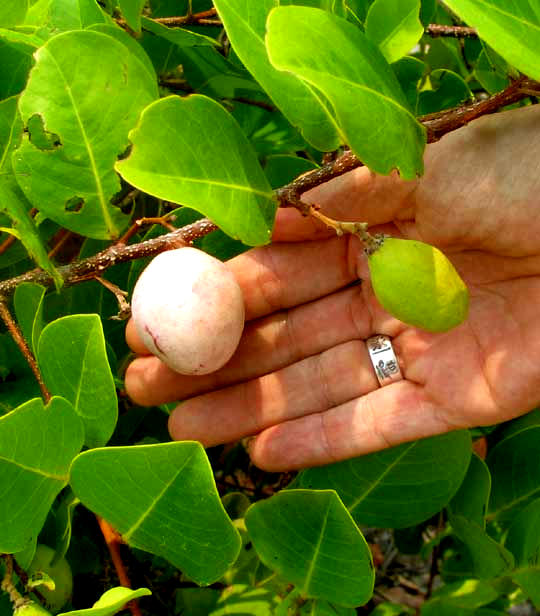
The white one was mature and rather nice to eat. White, sweet, melon-textured flesh surrounded a large seed. If you're hot and hungry while hiking the beach, you'd welcome finding this bush heavy with fruits. In fact, I hear that the fruits make a fine jam.
Among the fruits there were a few tiny blossoms, such as those shown below:
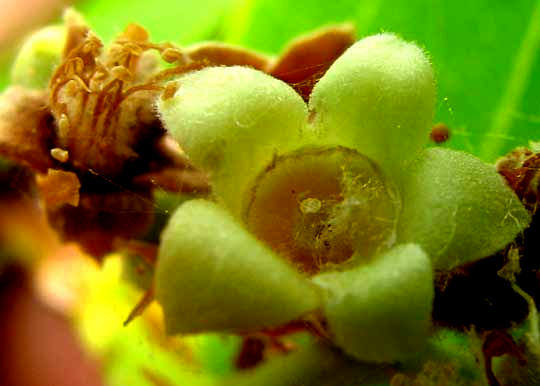
That picture is interesting because it shows two blossoms side by side, but the flowers are different. The older, fading one at the left bears numerous male stamens -- the items with slender filaments (stems) topped with oval, pollen-producing anthers. However, on the younger flower at the right, there's no sign of stamens. In that flower's center you see a round-topped, pollen-receiving stigma atop a slender style leading down into the flower, to the ovary nestled there like an upright egg in a bowl.
Bearing two such different flowers is possible for Icaco because the bushes can be "hermaphroditic, or andromonoecious, or gynomonoecious." Hermaphroditic plants are those on which all flowers bear both male and female parts. Andromonoecious plants bear both bisexual and strictly male flowers on the same plant. Gynomonoecious plants bear both bisexual and strictly female flowers on the same plant. It looks as if our flower picture shows a plant that's gynomonoecious, because the flower on the right is strictly female, while the older flower on the left appears to bear both male and female parts.
I searched for studies explaining how such a curious sexual orientation could be adaptive for an organism, but it appears that no one really knows. Lots of theories, but no clear experimental results.
Icaco is native from Mexico to northwestern South America, as well as the Caribbean and tropical western Africa. It's been naturalized in several places in Asia and Oceania.
from the June 14, 2015 Newsletter issued from Río Lagartos, on the Yucatan Peninsula's northern coast (~N21.60°, ~W88.16°), Yucatán state, MÉXICO
ICACO FRUITS
On very thin soil atop limestone bedrock at the edge of the mangroves a chest-high bush with semi-succulent leaves bore several yellow, plump, plum-like fruits, as shown below:
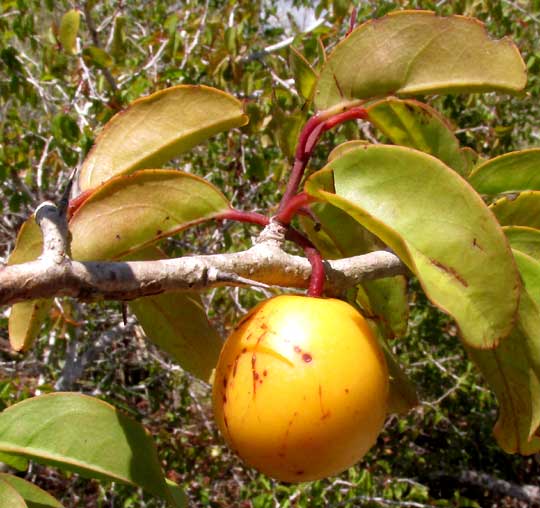
Biting into the fruit, the juicy flesh was a little acidy, a little bitter, but not bad. However, most of the fruit's interior was occupied by a large, spherical seed, as shown below:
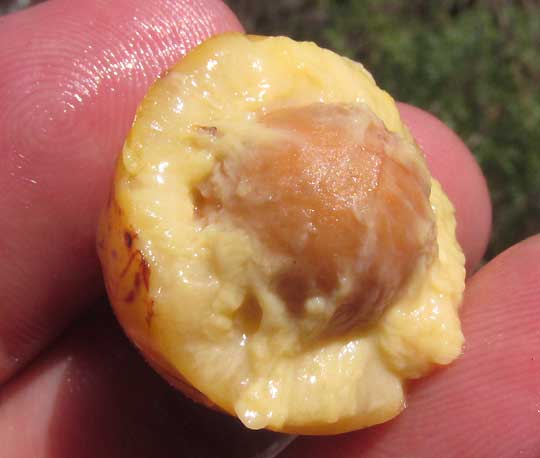
Once I saw the seed I realized that this was a bush and fruit that normally I encounter on sandy beaches. It was the Icaco or Cocoplum. This shrub's fruits were a little smaller and yellower than I was used to, and the leaves' petioles were reddish, which I didn't recall seeing on other plants. This particular beach-loving plant was in soil that much of the year is waterlogged, but which for the last few months had been extremely dry, and it often happens that plants under drought stress lose some of their green pigments causing remaining pigments to produce different colors.
Several Icaco subspecies and varieties are recognized, and often "coastal forms" and " inland forms" are spoken of. Wikipedia's page for the species refers to a "... coastal form being round, up to 5 cm in diameter, pale-yellow with rose blush or dark-purple in color, while that of the inland form is oval, up to 2.5 cm long, and dark-purple." Also the inland form is described as having reddish leaves. Our reddish-leafed, yellow-fruited individual doesn't match this description, but it's clear that Icaco is a variable species, and we're confirming that.